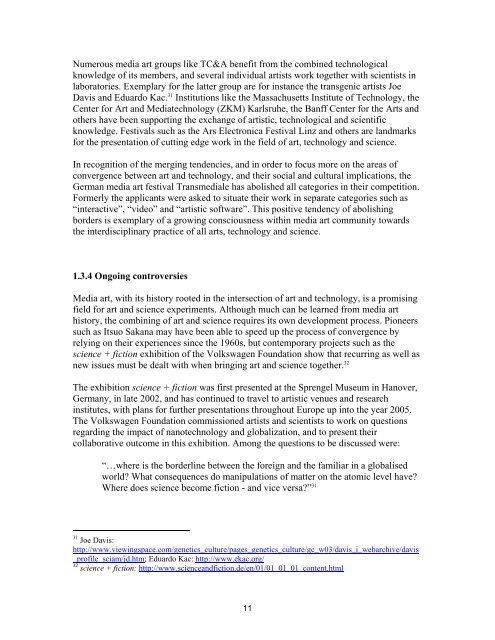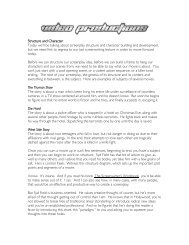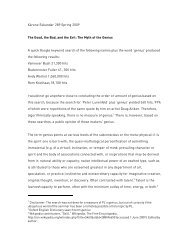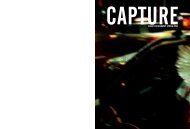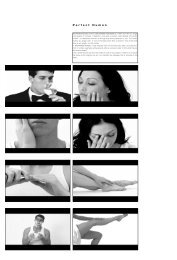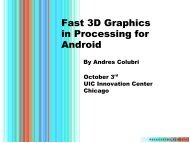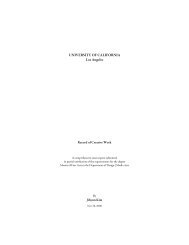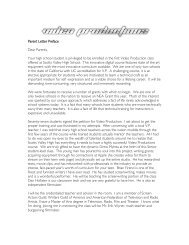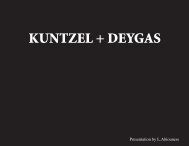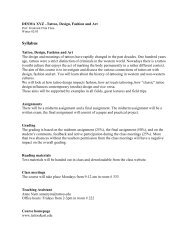Singing cells, art, science and the noise in between - Users - UCLA
Singing cells, art, science and the noise in between - Users - UCLA
Singing cells, art, science and the noise in between - Users - UCLA
Create successful ePaper yourself
Turn your PDF publications into a flip-book with our unique Google optimized e-Paper software.
Numerous media <strong>art</strong> groups like TC&A benefit from <strong>the</strong> comb<strong>in</strong>ed technological<br />
knowledge of its members, <strong>and</strong> several <strong>in</strong>dividual <strong>art</strong>ists work toge<strong>the</strong>r with scientists <strong>in</strong><br />
laboratories. Exemplary for <strong>the</strong> latter group are for <strong>in</strong>stance <strong>the</strong> transgenic <strong>art</strong>ists Joe<br />
Davis <strong>and</strong> Eduardo Kac. 31 Institutions like <strong>the</strong> Massachusetts Institute of Technology, <strong>the</strong><br />
Center for Art <strong>and</strong> Mediatechnology (ZKM) Karlsruhe, <strong>the</strong> Banff Center for <strong>the</strong> Arts <strong>and</strong><br />
o<strong>the</strong>rs have been support<strong>in</strong>g <strong>the</strong> exchange of <strong>art</strong>istic, technological <strong>and</strong> scientific<br />
knowledge. Festivals such as <strong>the</strong> Ars Electronica Festival L<strong>in</strong>z <strong>and</strong> o<strong>the</strong>rs are l<strong>and</strong>marks<br />
for <strong>the</strong> presentation of cutt<strong>in</strong>g edge work <strong>in</strong> <strong>the</strong> field of <strong>art</strong>, technology <strong>and</strong> <strong>science</strong>.<br />
In recognition of <strong>the</strong> merg<strong>in</strong>g tendencies, <strong>and</strong> <strong>in</strong> order to focus more on <strong>the</strong> areas of<br />
convergence <strong>between</strong> <strong>art</strong> <strong>and</strong> technology, <strong>and</strong> <strong>the</strong>ir social <strong>and</strong> cultural implications, <strong>the</strong><br />
German media <strong>art</strong> festival Transmediale has abolished all categories <strong>in</strong> <strong>the</strong>ir competition.<br />
Formerly <strong>the</strong> applicants were asked to situate <strong>the</strong>ir work <strong>in</strong> separate categories such as<br />
“<strong>in</strong>teractive”, “video” <strong>and</strong> “<strong>art</strong>istic software”. This positive tendency of abolish<strong>in</strong>g<br />
borders is exemplary of a grow<strong>in</strong>g consciousness with<strong>in</strong> media <strong>art</strong> community towards<br />
<strong>the</strong> <strong>in</strong>terdiscipl<strong>in</strong>ary practice of all <strong>art</strong>s, technology <strong>and</strong> <strong>science</strong>.<br />
1.3.4 Ongo<strong>in</strong>g controversies<br />
Media <strong>art</strong>, with its history rooted <strong>in</strong> <strong>the</strong> <strong>in</strong>tersection of <strong>art</strong> <strong>and</strong> technology, is a promis<strong>in</strong>g<br />
field for <strong>art</strong> <strong>and</strong> <strong>science</strong> experiments. Although much can be learned from media <strong>art</strong><br />
history, <strong>the</strong> comb<strong>in</strong><strong>in</strong>g of <strong>art</strong> <strong>and</strong> <strong>science</strong> requires its own development process. Pioneers<br />
such as Itsuo Sakana may have been able to speed up <strong>the</strong> process of convergence by<br />
rely<strong>in</strong>g on <strong>the</strong>ir experiences s<strong>in</strong>ce <strong>the</strong> 1960s, but contemporary projects such as <strong>the</strong><br />
<strong>science</strong> + fiction exhibition of <strong>the</strong> Volkswagen Foundation show that recurr<strong>in</strong>g as well as<br />
new issues must be dealt with when br<strong>in</strong>g<strong>in</strong>g <strong>art</strong> <strong>and</strong> <strong>science</strong> toge<strong>the</strong>r. 32<br />
The exhibition <strong>science</strong> + fiction was first presented at <strong>the</strong> Sprengel Museum <strong>in</strong> Hanover,<br />
Germany, <strong>in</strong> late 2002, <strong>and</strong> has cont<strong>in</strong>ued to travel to <strong>art</strong>istic venues <strong>and</strong> research<br />
<strong>in</strong>stitutes, with plans for fur<strong>the</strong>r presentations throughout Europe up <strong>in</strong>to <strong>the</strong> year 2005.<br />
The Volkswagen Foundation commissioned <strong>art</strong>ists <strong>and</strong> scientists to work on questions<br />
regard<strong>in</strong>g <strong>the</strong> impact of nanotechnology <strong>and</strong> globalization, <strong>and</strong> to present <strong>the</strong>ir<br />
collaborative outcome <strong>in</strong> this exhibition. Among <strong>the</strong> questions to be discussed were:<br />
“…where is <strong>the</strong> borderl<strong>in</strong>e <strong>between</strong> <strong>the</strong> foreign <strong>and</strong> <strong>the</strong> familiar <strong>in</strong> a globalised<br />
world? What consequences do manipulations of matter on <strong>the</strong> atomic level have?<br />
Where does <strong>science</strong> become fiction - <strong>and</strong> vice versa?” 31<br />
31 Joe Davis:<br />
http://www.view<strong>in</strong>gspace.com/genetics_culture/pages_genetics_culture/gc_w03/davis_j_webarchive/davis<br />
_profile_sciam/jd.htm; Eduardo Kac: http://www.ekac.org/<br />
32 <strong>science</strong> + fiction: http://www.<strong>science</strong><strong>and</strong>fiction.de/en/01/01_01_01_content.html<br />
11


